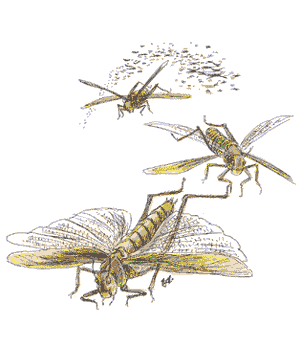

2140

| Velvet Ant | Grasshopper and Locust | |
|---|---|---|
| Climate/Terrain: | Tropical, subtropical or temperate/Forest, hills,and plains | Tropical and subtropical/Forest, hills, and plains |
| Frequency: | Very rare | Very rare |
| Organization: | Swarm | Swarm |
| Activity Cycle: | Day | Day |
| Diet: | Omnivore | Herbivore |
| Intelligence: | Animal (1) | Animal (1) |
| Treasure: | Nil | Nil |
| Alignment: | Neutral | Neutral |
| No. Appearing: | See below | See below |
| Armor Class: | 8 | 8 |
| Movement: | 6 | 6, Fl 18 (C) |
| Hit Dice: | See below | 1 hp/20 insects |
| THAC0: | See below | See below |
| No. of Attacks: | 1 | 1 |
| Damage/Attack: | See below | See below |
| Special Attacks: | Poison | Nil |
| Special Defenses: | Nil | Nil |
| Magic Resistance: | Nil | Nil |
| Size: | Individual: T (1� long); Swarm: see below | T (2� long); Swarm: see below |
| Morale: | Unsteady (6) | Unsteady (6) |
| XP Value: | See below | See below |
As individuals, velvet ants, grasshoppers, and locusts are relatively harmless. But in swarms, these insects can cause immense damage to fields and forests, as well as threatening the lives of all creatures in their path.
The velvet ant resembles a plump version of the common ant, except for the soft fuzz that covers its entire body. The fuzz is usually red or black, but it can also be yellow, brown, or orange.
Combat: A velvet ant swarm eats everything in its path, animal matter as well as vegetation. To determine the size of a swarm, roll 1d100 and multiply the result by 1,000. There are about 100 ants per square foot; therefore, a swarm of 10,000 ants forms a block about 10 feet per side. If a swarm comes in contact with an obstacle, it turns 90 and continues. A victim in contact with a swarm has an 80% chance per round of being bitten and suffering 1d4 points of damage. The victim must roll a successful saving throw vs. poison or suffer intense pain for the next 2d4 turns, making all attack and damage rolls with a -2 penalty during this time.
Each point of damage inflicted on an insect swarm kills 1d20 insects. They may be scattered with smoke or fire; immersion in water washes them off. If half of a swarm is killed, the survivors attempt to scatter and hide. If an entire swarm is killed, award 975 experience points.
The grasshopper is about 2 inches in length and is usually green or brown in color. The grasshopper can make leaps of about four feet. Locusts are a type of grasshopper, with shorter antennae. They can rub their hind legs against their wings to produce a distinctive chirp.
Combat: Grasshopper and locust swarms fly from place to place in search of lush fields on which to settle and consume. These swarms move in straight lines and are easy to avoid.
To determine the size of a grasshopper swarm, roll 1d100 and multiply the result by 10,000. Multiply this result by 2 when determining the size of a locust swarm. There are about 20 grasshoppers or locusts per square foot (for convenience, assume there are 20 insects per cubic foot when approximating the size of flying swarm).
A victim in contact with a grasshopper or locust swarm has a 90% chance per round of being bitten and suffering 1 point of damage. Additionally, victims within a cloud of these insects have their vision reduced to 2d4 feet.
Each point of damage inflicted on an insect swarm kills 1d20 insects. They may be scattered with smoke or fire; immersion in water washes them off. If half of a swarm is killed, the survivors attempt to scatter.
If an entire swarm is killed, award 2,000 experience points.
Habitat/Society: Insect swarms are migratory, sleeping at night wherever they happen to be. Females lay up to 100 eggs every year. These insects have no leaders or any specialized workers. They do not collect treasure.
Ecology: Velvet ants eat seeds, grasses, and meat, especially enjoying carrion. The poison of velvet ants renders them inedible to carnivores.
Grasshoppers and locusts prefer seeds and grains. Snakes, mice, birds, and spiders are among these insects� numerous natural enemies. Grasshoppers and locusts can be eaten by carnivores.
Last Modified: April 22, 2009, 13:15:46 GMT

◆ 1049 ◆